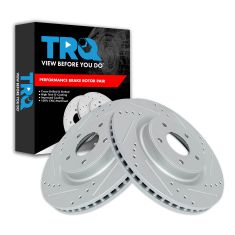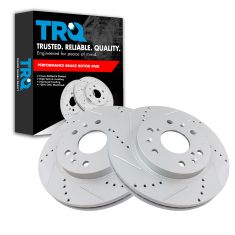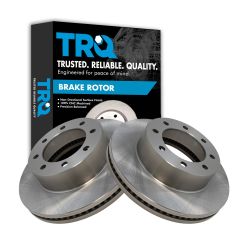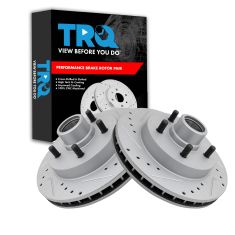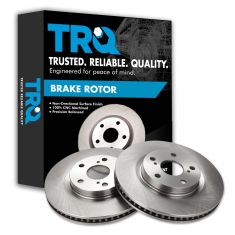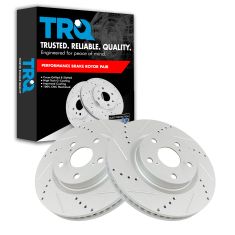Brake Rotors
-
-
- Air Deflectors & Valance Panels
- Battery Trays & Related
- Body Panels
- Bumpers & Related - Front & Rear
- Convertible Tops, Soft Tops, & Parts
- Decal & Stripe Kits
- Emblems & Nameplates
- Engine Compartment Trim
- Frame Parts & Bushings
- Fuel Door Parts
- Fuel Tank Filler Neck
- Grille
- Header Panel
- Hood & Hatch Lift Supports
- Hood Latch & Catch Brackets
- Hood Release Cable
- Jack Pads
- Radiator Supports
- Rust Repair Panels
- Splash Shields & Fender Liners
- Tailgate Cables
- Tailgate Hinges & Related
- Weatherstripping
-
- Car Covers
- Exterior Lighting
- Exterior Parts & Accessories
- Exterior Safety & Security
- Exterior Storage
- Fender Flares
- License Plate Brackets & Frames
- Mud Flaps & Splash Guards
- Nerf Bars, Side Steps, Running Boards
- Radio Antenna
- Rain Deflectors
- Roll Bars, Light Bars, & Related
- Roof Rack
- Skid Plates
- Spare Tire Carriers & Related
- Spare Tire Covers
- Tire Care
- Tonneau Covers
- Tow Hooks & D-Shackles
- Towing Accessories
- Trailer Hitch & Components
-
- Accelerator Pedal Pad
- Auto Carpet
- Brake Pedal Pad
- Clutch Pedal Pad
- Console Parts
- Dash Pad Cover
- Dash Vents
- Floor Mats & Liners
- Horns & Horn Parts
- Interior Parts & Accessories
- Mirror - Interior Rear View
- Seat Cover and Sets
- Seat Heater Kits
- Seat Parts and Accessories
- Sun Visors & Related
- Trunk & Cargo Parts
-
- Accelerator Pedals & Sensors
- Alarms, Control Modules, & Remote Start
- Cruise Control Switch & Lever
- Electrical Parts
- Hazard Switch
- Ignition Key Lock Cylinder
- Ignition Switch
- Keyless Entry Remote & Related
- Neutral Safety Switch
- Parking Assist Cameras & Monitors
- Power Mirror Switch
- Power Seat Switches
- Power Window Switch
- Radio, Navigation, Entertainment
- Reverse Light Switch
- Trunk Release & Lock Solenoids
- Turn Signal Switches and Levers
- Windshield Wiper Switch
-
- Idler Arm
- Pitman Arm
- Power Steering Hoses
- Power Steering Oil Cooler
- Power Steering Pressure Sensor
- Power Steering Pump
- Power Steering Pump Cooling Fan
- Power Steering Pump Pulley
- Power Steering Pump Reservoir
- Steering Dampers
- Steering Knuckles and Spindles
- Steering Rack and Gear Boxes
- Steering Shafts & Couplers
- Steering Wheels & Column Parts
- Tie Rods & Adjusting Sleeves
-
-
-
-
-
-
2878
288
10
10
-
Notify When Available
Replaces Nissan Infiniti Front Driver & Passenger Side Performance 2 Piece Brake Rotor Set TRQ Performance BRA74989
Brand: TRQ Performance - BRA74989$129.95Save 26%List $174.95 Save $45.00Brand: TRQ Performance - BRA74989$129.95Save 26%List $174.95 Save $45.00 -
Notify When Available
Replaces Chevrolet GMC Isuzu Front Driver & Passenger Side Performance 2 Piece Brake Rotor Set TRQ Performance BRA74671
Brand: TRQ Performance - BRA74671$129.95Save 25%List $172.95 Save $43.00Brand: TRQ Performance - BRA74671$129.95Save 25%List $172.95 Save $43.00 -
Notify When Available
Replaces Chevrolet GMC Cadillac Front Driver & Passenger Side Performance 2 Piece Brake Rotor Set TRQ Performance BRA74615
Brand: TRQ Performance - BRA74615$179.95Save 29%List $251.95 Save $72.00Brand: TRQ Performance - BRA74615$179.95Save 29%List $251.95 Save $72.00 -
Notify When Available
Replaces Hyundai Kia Front Driver & Passenger Side 2 Piece Performance Brake Rotor Set TRQ Performance BRA25207
Brand: TRQ Performance - BRA25207$99.95Save 30%List $142.95 Save $43.00Brand: TRQ Performance - BRA25207$99.95Save 30%List $142.95 Save $43.00 -
Notify When Available
Replaces Nissan Infiniti Front Driver & Passenger Side 2 Piece Brake Rotor Set TRQ BRA78301
Brand: TRQ - BRA78301$114.95Save 26%List $154.95 Save $40.00Brand: TRQ - BRA78301$114.95Save 26%List $154.95 Save $40.00 -
Notify When Available
Replaces 2013-22 Ford Rear Driver & Passenger Side 2 Piece Brake Rotor Set TRQ BRA78292
Brand: TRQ - BRA78292$194.95Save 32%List $284.95 Save $90.00Brand: TRQ - BRA78292$194.95Save 32%List $284.95 Save $90.00 -
Notify When Available
Replaces Ford Front Driver & Passenger Side 2 Piece Brake Rotor Set TRQ BRA78291
Brand: TRQ - BRA78291$199.95Save 24%List $261.95 Save $62.00Brand: TRQ - BRA78291$199.95Save 24%List $261.95 Save $62.00 -
Notify When Available
Replaces Chevrolet GMC Front Driver & Passenger Side Performance 2 Piece Brake Rotor Set TRQ Performance BRA74903
Brand: TRQ Performance - BRA74903$165.95Save 40%List $276.95 Save $111.00Brand: TRQ Performance - BRA74903$165.95Save 40%List $276.95 Save $111.00 -
Notify When Available
Replaces Toyota Lexus Pontiac Scion Front Driver & Passenger Side 2 Piece Brake Rotor Set TRQ BRA75204
Brand: TRQ - BRA75204$94.95Save 22%List $121.95 Save $27.00Replaces Toyota Lexus Pontiac Scion Front Driver & Passenger Side 2 Piece Brake Rotor Set TRQ BRA75204
Brand: TRQ - BRA75204$94.95Save 22%List $121.95 Save $27.00 -
Notify When Available
Replaces Toyota Lexus Pontiac Scion Front Driver & Passenger Side Performance 2 Piece Brake Rotor Set TRQ Performance BRA74619
Brand: TRQ Performance - BRA74619$104.95Save 26%List $140.95 Save $36.00Brand: TRQ Performance - BRA74619$104.95Save 26%List $140.95 Save $36.00
loading...
Choose the Make of Your Vehicle
